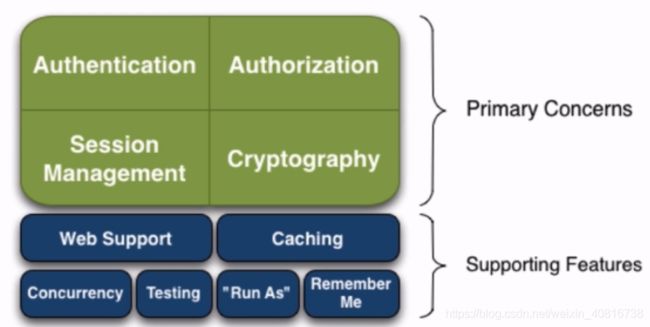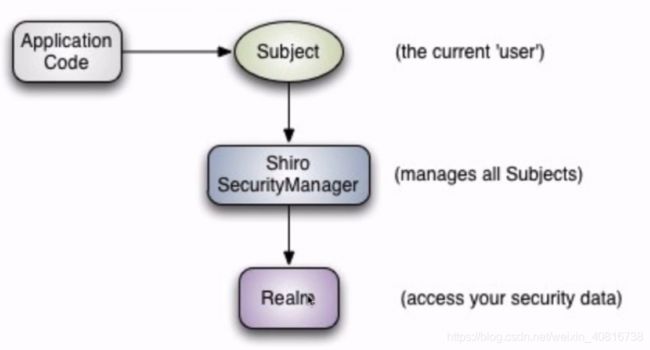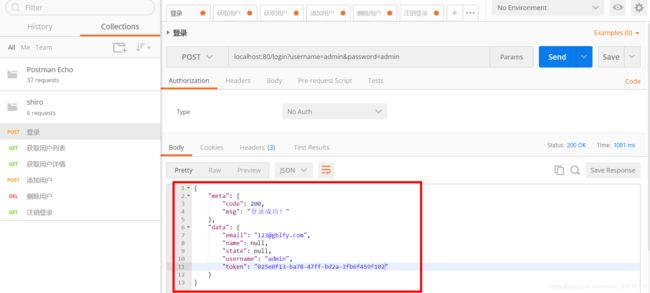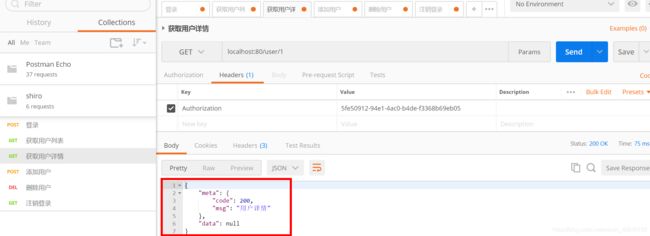SpringBoot集成Shiro前后端分离使用redis做缓存
文章目录
- 一 、shiro介绍
- 1、基础介绍
- 2、基本功能点
- 3、基本流程图
- 二、 常用的权限管理表关系
- 2.1. 表组成
- 2.2. 表结构
- 三、实战案例
- 3.1. 案例介绍
- 3.2. 依赖
- 3.3. Shiro全局配置
- 3.4. 自定义ShiroRealm
- 3.5. ShiroUtils
- 3.6. 自定义SessionManager
- 3.7. 登录/出主方法
- 3.8. 测试主方法
- 四、 前后端分离需要注意的点
- 五、测试验链接
- 六、测试验证
- 6.1. 登录测试
- 6.1. 1. 链接
- 6.1. 2. 参数
- 6.1. 3. 登陆后的token
- 6.2. 获取用户列表
- 6.2. 1. 链接
- 6.2. 2. 参数
- 6.3. 获取用户详情
- 6.3. 1. 链接
- 6.3. 2. 参数
- 6.4. 添加用户
- 6.4. 1. 链接
- 6.4. 2. 参数
- 6.5. 删除用户
- 6.5. 1. 链接
- 6.5. 2. 参数
- 6.6. 注销登录
- 6.6. 1. 链接
- 6.6. 2. 参数
技术选型
| 框架 | 说明 | 版本 |
|---|---|---|
| 环境 | JDK | 1.8 |
| 后台 | SpringBoot | 2.1.7.RELEASE |
| 权限控制 | Shiro | 1.4.0 |
| 数据库 | Mysql | 8.0.17 |
| 数据源 | druid | 1.1.10 |
| 持久层 | mybatis | 1.3.2 |
| 缓存 | shiro-redis | 3.1.0 |
一 、shiro介绍
1、基础介绍
Apache Shiro是一个强大且易用的Java安全框架,执行身份验证、授权、密码和会话管理。作为一款安全框架Shiro的设计相当巧妙。Shiro的应用不依赖任何容器,它不仅可以在JavaEE下使用,还可以应用在JavaSE环境中。
2、基本功能点
1、Authentication:身份认证/登录,验证用户是不是拥有相应的身份。
2、Authorization:授权,即权限验证,验证某个已认证的用户是否拥有某个权限;即判断用户是否能做事情,常见的如:验证某个用户是否拥有某个角色。或者细粒度的验证某个用户对某个资源是否具有某个权限。
3、Session Manager:会话管理,即用户登录后就是一次会话,在没有退出之前,它的所有信息都在会话中;会话可以是普通JavaSE环境的,也可以是如Web环境的。
4、Cryptography:加密,保护数据的安全性,如密码加密存储到数据库,而不是明文存储。
5、Web Support:Web支持,可以非常容易的集成到Web环境。
6、Caching:缓存,比如用户登录后,其用户信息、拥有的角色/权限不必每次去查,这样可以提高效率。
7、Concurrency:shiro支持多线程应用的并发验证,即如在一个线程中开启另一个线程,能把权限自动传播过去。
8、Testing:提供测试支持。
9、Run As:允许一个用户假装为另一个用户(如果他们允许)的身份进行访问。
10、Remember Me:记住我,这个是非常常见的功能,即一次登录后,下次再来的话不用登录了。
3、基本流程图
Subject:主体,代表了当前“用户”,这个用户不一定是一个具体的人,与当前应用交互的任何东西都是Subject,如网络爬虫,机器人等;即一个抽象概念;所有Subject都绑定到SecurityManager,与Subject的所有交互都会委托给SecurityManager;可以把Subject认为是一个门面;SecurityManager才是实际的执行者。
SecurityManager:安全管理器;即所有与安全有关的操作都会与SecurityManager交互;且它管理着所有Subject;可以看出它是Shiro的核心,它负责与后边介绍的其他组件进行交互,如果学习过SpringMVC,你可以把它看成DispatcherServlet前端控制器。
Realm:域,Shiro从从Realm获取安全数据(如用户、角色、权限),就是说SecurityManager要验证用户身份,那么它需要从Realm获取相应的用户进行比较以确定用户身份是否合法;也需要从Realm得到用户相应的角色/权限进行验证用户是否能进行操作;可以把Realm看成DataSource,即安全数据源。
流程如下:
步骤一:Shiro把用户的数据封装成标识token,token一般封装着用户名,密码等信息。
步骤二:使用Subject门面获取到封装着用户的数据的标识token
步骤三:Subject把标识token交给SecurityManager,在SecurityManager安全中心中,SecurityManager把标识token委托给认证器Authenticator进行身份验证。认证器的作用一般是用来指定如何验证,它规定本次认证用到哪些Realm。
步骤四:认证器Authenticator将传入的标识token,与数据源Realm对比,验证token是否合法。
二、 常用的权限管理表关系
2.1. 表组成
- 5张表,也就是现在流行的权限设计模型RBAC
分别是:用户表 ,角色表,菜单(权限)表 , 用户和角色关联表,角色和菜单关联表
2.2. 表结构
-- 表结构总览--
-- 权限表--
DROP TABLE IF EXISTS `menu`;
CREATE TABLE `menu` (
`menu_id` bigint(20) NOT NULL AUTO_INCREMENT,
`parent_id` bigint(20) DEFAULT NULL COMMENT '父菜单ID,一级菜单为0',
`name` varchar(50) DEFAULT NULL COMMENT '菜单名称',
`url` varchar(200) DEFAULT NULL COMMENT '菜单URL',
`perms` varchar(500) DEFAULT NULL COMMENT '授权(多个用逗号分隔,如:user:list,user:create)',
`type` int(11) DEFAULT NULL COMMENT '类型 0:目录 1:菜单 2:按钮',
`icon` varchar(50) DEFAULT NULL COMMENT '菜单图标',
`order_num` int(11) DEFAULT NULL COMMENT '排序',
`create_time` datetime DEFAULT CURRENT_TIMESTAMP COMMENT '创建时间',
`update_time` datetime DEFAULT CURRENT_TIMESTAMP ON UPDATE CURRENT_TIMESTAMP COMMENT '更新时间',
PRIMARY KEY (`menu_id`)
) ENGINE=InnoDB DEFAULT CHARSET=utf8 COMMENT='菜单管理';
LOCK TABLES `menu` WRITE;
INSERT INTO `menu` (`menu_id`, `parent_id`, `name`, `url`, `perms`, `type`, `icon`, `order_num`, `create_time`, `update_time`)
VALUES
(1,0,'权限菜单','menu/list','menu:list',0,'system',0,'2019-08-30 03:06:59','2019-08-30 07:38:01'),
(2,0,'用户列表','user/list','user:list',0,'user',0,'2019-08-30 07:38:46','2019-08-30 07:38:56'),
(3,0,'用户详情','user/detail','user:detail',0,'user',0,'2019-08-30 07:38:52','2019-08-30 07:39:43'),
(4,0,'添加用户','user/add','user:add',0,'user',0,'2019-08-30 07:38:52','2019-08-30 07:42:54');
UNLOCK TABLES;
-- 角色表表--
DROP TABLE IF EXISTS `role`;
CREATE TABLE `role` (
`role_id` bigint(20) NOT NULL AUTO_INCREMENT,
`role_name` varchar(100) DEFAULT NULL COMMENT '角色名称',
`remark` varchar(100) DEFAULT NULL COMMENT '备注',
`create_user_id` bigint(20) DEFAULT NULL COMMENT '创建者ID',
`create_time` datetime DEFAULT CURRENT_TIMESTAMP COMMENT '创建时间',
`update_time` datetime DEFAULT CURRENT_TIMESTAMP ON UPDATE CURRENT_TIMESTAMP COMMENT '更新时间',
PRIMARY KEY (`role_id`)
) ENGINE=InnoDB DEFAULT CHARSET=utf8 COMMENT='角色';
LOCK TABLES `role` WRITE;
INSERT INTO `role` (`role_id`, `role_name`, `remark`, `create_user_id`, `create_time`, `update_time`)
VALUES
(1,'admin','超级管理员',1,'2019-08-30 07:41:08','2019-08-30 07:41:08');
UNLOCK TABLES;
-- 角色和权限的关系表--
DROP TABLE IF EXISTS `role_menu`;
CREATE TABLE `role_menu` (
`id` bigint(20) NOT NULL AUTO_INCREMENT,
`role_id` bigint(20) DEFAULT NULL COMMENT '角色ID',
`menu_id` bigint(20) DEFAULT NULL COMMENT '菜单ID',
`create_time` datetime DEFAULT CURRENT_TIMESTAMP COMMENT '创建时间',
`update_time` datetime DEFAULT CURRENT_TIMESTAMP ON UPDATE CURRENT_TIMESTAMP COMMENT '更新时间',
PRIMARY KEY (`id`)
) ENGINE=InnoDB DEFAULT CHARSET=utf8 COMMENT='角色与菜单对应关系';
LOCK TABLES `role_menu` WRITE;
INSERT INTO `role_menu` (`id`, `role_id`, `menu_id`, `create_time`, `update_time`)
VALUES
(1,1,1,'2019-08-30 07:41:16','2019-08-30 07:41:16'),
(3,1,3,'2019-08-30 07:41:28','2019-08-30 07:41:28'),
(4,1,4,'2019-08-30 07:46:14','2019-08-30 07:46:14');
UNLOCK TABLES;
-- 用户表--
DROP TABLE IF EXISTS `user`;
CREATE TABLE `user` (
`user_id` bigint(20) NOT NULL AUTO_INCREMENT,
`username` varchar(50) NOT NULL COMMENT '用户名',
`password` varchar(100) DEFAULT NULL COMMENT '密码',
`salt` varchar(20) DEFAULT NULL COMMENT '盐',
`email` varchar(100) DEFAULT NULL COMMENT '邮箱',
`mobile` varchar(100) DEFAULT NULL COMMENT '手机号',
`name` varchar(100) DEFAULT NULL COMMENT '姓名',
`status` tinyint(4) DEFAULT NULL COMMENT '状态 0:禁用 1:正常',
`create_user_id` bigint(20) DEFAULT NULL COMMENT '创建者ID',
`create_time` datetime DEFAULT CURRENT_TIMESTAMP COMMENT '创建时间',
`update_time` datetime DEFAULT CURRENT_TIMESTAMP ON UPDATE CURRENT_TIMESTAMP COMMENT '更新时间',
PRIMARY KEY (`user_id`),
UNIQUE KEY `username` (`username`)
) ENGINE=InnoDB DEFAULT CHARSET=utf8 COMMENT='系统用户';
LOCK TABLES `user` WRITE;
INSERT INTO `user` (`user_id`, `username`, `password`, `salt`, `email`, `mobile`, `name`, `status`, `create_user_id`, `create_time`, `update_time`)
VALUES
(1,'admin','3743a4c09a17e6f2829febd09ca54e627810001cf255ddcae9dabd288a949c4a','123','[email protected]','18967835678',NULL,1,1,'2019-01-18 11:11:11','2019-01-18 11:11:11');
UNLOCK TABLES;
-- 用户和角色关系表
DROP TABLE IF EXISTS `user_role`;
CREATE TABLE `user_role` (
`id` bigint(20) NOT NULL AUTO_INCREMENT,
`user_id` bigint(20) DEFAULT NULL COMMENT '用户ID',
`role_id` bigint(20) DEFAULT NULL COMMENT '角色ID',
`create_time` datetime DEFAULT CURRENT_TIMESTAMP COMMENT '创建时间',
`update_time` datetime DEFAULT CURRENT_TIMESTAMP ON UPDATE CURRENT_TIMESTAMP COMMENT '更新时间',
PRIMARY KEY (`id`)
) ENGINE=InnoDB DEFAULT CHARSET=utf8 COMMENT='用户与角色对应关系';
LOCK TABLES `user_role` WRITE;
INSERT INTO `user_role` (`id`, `user_id`, `role_id`, `create_time`, `update_time`)
VALUES
(1,1,1,'2019-08-30 07:40:51','2019-08-30 07:40:51');
UNLOCK TABLES;
注:建表语句在项目中
三、实战案例
3.1. 案例介绍
3.2. 依赖
org.springframework.boot
spring-boot-starter-web
org.mybatis.spring.boot
mybatis-spring-boot-starter
${mybatis.version}
com.alibaba
druid-spring-boot-starter
${druid.version}
mysql
mysql-connector-java
runtime
org.projectlombok
lombok
true
org.apache.shiro
shiro-spring
${shiro-spring.version}
org.crazycake
shiro-redis
${shiro-redis.version}
3.3. Shiro全局配置
package com.gblfy.shiro.config;
import lombok.Data;
import lombok.extern.slf4j.Slf4j;
import org.apache.shiro.mgt.SecurityManager;
import org.apache.shiro.session.mgt.SessionManager;
import org.apache.shiro.session.mgt.eis.JavaUuidSessionIdGenerator;
import org.apache.shiro.spring.security.interceptor.AuthorizationAttributeSourceAdvisor;
import org.apache.shiro.spring.web.ShiroFilterFactoryBean;
import org.apache.shiro.web.mgt.DefaultWebSecurityManager;
import org.apache.shiro.web.servlet.SimpleCookie;
import org.crazycake.shiro.RedisCacheManager;
import org.crazycake.shiro.RedisManager;
import org.crazycake.shiro.RedisSessionDAO;
import org.springframework.aop.framework.autoproxy.DefaultAdvisorAutoProxyCreator;
import org.springframework.boot.context.properties.ConfigurationProperties;
import org.springframework.context.annotation.Bean;
import org.springframework.context.annotation.Configuration;
import java.time.Duration;
import java.util.LinkedHashMap;
import java.util.Map;
/**
* @Author: http://gblfy.com
* @Version 1.0.0
*/
@Configuration
@Slf4j
@Data
@ConfigurationProperties(prefix = "spring.redis")
public class ShiroConfig {
private String host = "localhost";
private int port = 6379;
private Duration timeout;
/**
* Filter工厂,设置对应的过滤条件和跳转条件
*
* @return ShiroFilterFactoryBean
*/
@Bean
public ShiroFilterFactoryBean shirFilter(SecurityManager securityManager) {
ShiroFilterFactoryBean shiroFilterFactoryBean = new ShiroFilterFactoryBean();
shiroFilterFactoryBean.setSecurityManager(securityManager);
// 过滤器链定义映射
Map filterChainDefinitionMap = new LinkedHashMap<>();
/*
* anon:所有url都都可以匿名访问,authc:所有url都必须认证通过才可以访问;
* 过滤链定义,从上向下顺序执行,authc 应放在 anon 下面
* */
filterChainDefinitionMap.put("/login", "anon");
// 配置不会被拦截的链接 顺序判断,如果前端模板采用了thymeleaf,这里不能直接使用 ("/static/**", "anon")来配置匿名访问,必须配置到每个静态目录
filterChainDefinitionMap.put("/css/**", "anon");
filterChainDefinitionMap.put("/fonts/**", "anon");
filterChainDefinitionMap.put("/img/**", "anon");
filterChainDefinitionMap.put("/js/**", "anon");
filterChainDefinitionMap.put("/html/**", "anon");
// 所有url都必须认证通过才可以访问
filterChainDefinitionMap.put("/**", "authc");
// 配置退出 过滤器,其中的具体的退出代码Shiro已经替我们实现了, 位置放在 anon、authc下面
filterChainDefinitionMap.put("/logout", "logout");
// 如果不设置默认会自动寻找Web工程根目录下的"/login.jsp"页面
// 配器shirot认登录累面地址,前后端分离中登录累面跳转应由前端路由控制,后台仅返回json数据, 对应LoginController中unauth请求
shiroFilterFactoryBean.setLoginUrl("/un_auth");
// 登录成功后要跳转的链接, 此项目是前后端分离,故此行注释掉,登录成功之后返回用户基本信息及token给前端
// shiroFilterFactoryBean.setSuccessUrl("/index");
// 未授权界面, 对应LoginController中 unauthorized 请求
shiroFilterFactoryBean.setUnauthorizedUrl("/unauthorized");
shiroFilterFactoryBean.setFilterChainDefinitionMap(filterChainDefinitionMap);
return shiroFilterFactoryBean;
}
/**
* RedisSessionDAO shiro sessionDao层的实现 通过redis, 使用的是shiro-redis开源插件
*
* @return RedisSessionDAO
*/
@Bean
public RedisSessionDAO redisSessionDAO() {
RedisSessionDAO redisSessionDAO = new RedisSessionDAO();
redisSessionDAO.setRedisManager(redisManager());
redisSessionDAO.setSessionIdGenerator(sessionIdGenerator());
redisSessionDAO.setExpire(1800);
return redisSessionDAO;
}
/**
* Session ID 生成器
*
* @return JavaUuidSessionIdGenerator
*/
@Bean
public JavaUuidSessionIdGenerator sessionIdGenerator() {
return new JavaUuidSessionIdGenerator();
}
/**
* 自定义sessionManager
*
* @return SessionManager
*/
@Bean
public SessionManager sessionManager() {
MySessionManager mySessionManager = new MySessionManager();
mySessionManager.setSessionDAO(redisSessionDAO());
return mySessionManager;
}
/**
* 配置shiro redisManager, 使用的是shiro-redis开源插件
*
* @return RedisManager
*/
private RedisManager redisManager() {
RedisManager redisManager = new RedisManager();
redisManager.setHost(host);
redisManager.setPort(port);
redisManager.setTimeout((int) timeout.toMillis());
return redisManager;
}
/**
* cacheManager 缓存 redis实现, 使用的是shiro-redis开源插件
*
* @return RedisCacheManager
*/
@Bean
public RedisCacheManager cacheManager() {
RedisCacheManager redisCacheManager = new RedisCacheManager();
redisCacheManager.setRedisManager(redisManager());
// 必须要设置主键名称,shiro-redis 插件用过这个缓存用户信息
redisCacheManager.setPrincipalIdFieldName("userId");
return redisCacheManager;
}
/**
* 权限管理,配置主要是Realm的管理认证
*
* @return SecurityManager
*/
@Bean
public SecurityManager securityManager(ShiroRealm shiroRealm) {
DefaultWebSecurityManager securityManager = new DefaultWebSecurityManager();
securityManager.setRealm(shiroRealm);
// 自定义session管理 使用redis
securityManager.setSessionManager(sessionManager());
// 自定义缓存实现 使用redis
securityManager.setCacheManager(cacheManager());
return securityManager;
}
/*
* 开启Shiro的注解(如@RequiresRoles,@RequiresPermissions),需借助SpringAOP扫描使用Shiro注解的类,并在必要时进行安全逻辑验证
* 配置以下两个bean(DefaultAdvisorAutoProxyCreator(可选)和AuthorizationAttributeSourceAdvisor)即可实现此功能
*/
@Bean
public DefaultAdvisorAutoProxyCreator advisorAutoProxyCreator() {
DefaultAdvisorAutoProxyCreator advisorAutoProxyCreator = new DefaultAdvisorAutoProxyCreator();
advisorAutoProxyCreator.setProxyTargetClass(true);
return advisorAutoProxyCreator;
}
@Bean
public AuthorizationAttributeSourceAdvisor authorizationAttributeSourceAdvisor(SecurityManager securityManager) {
AuthorizationAttributeSourceAdvisor authorizationAttributeSourceAdvisor = new AuthorizationAttributeSourceAdvisor();
authorizationAttributeSourceAdvisor.setSecurityManager(securityManager);
return authorizationAttributeSourceAdvisor;
}
@Bean
public SimpleCookie cookie() {
// cookie的name,对应的默认是 JSESSIONID
SimpleCookie cookie = new SimpleCookie("SHARE_JSESSIONID");
cookie.setHttpOnly(true);
// path为 / 用于多个系统共享 JSESSIONID
cookie.setPath("/");
return cookie;
}
/* 此项目使用 shiro 场景为前后端分离项目,这里先注释掉,统一异常处理已在 GlobalExceptionHand.java 中实现 */
}
3.4. 自定义ShiroRealm
package com.gblfy.shiro.config;
import com.gblfy.shiro.entity.Role;
import com.gblfy.shiro.util.ShiroUtils;
import com.gblfy.shiro.entity.Menu;
import com.gblfy.shiro.entity.User;
import com.gblfy.shiro.mapper.MenuMapper;
import com.gblfy.shiro.mapper.RoleMapper;
import com.gblfy.shiro.mapper.UserMapper;
import lombok.extern.slf4j.Slf4j;
import org.apache.commons.collections4.CollectionUtils;
import org.apache.shiro.authc.*;
import org.apache.shiro.authc.credential.CredentialsMatcher;
import org.apache.shiro.authc.credential.HashedCredentialsMatcher;
import org.apache.shiro.authz.AuthorizationInfo;
import org.apache.shiro.authz.SimpleAuthorizationInfo;
import org.apache.shiro.realm.AuthorizingRealm;
import org.apache.shiro.subject.PrincipalCollection;
import org.apache.shiro.util.ByteSource;
import org.springframework.beans.factory.annotation.Autowired;
import org.springframework.stereotype.Component;
import java.util.List;
import java.util.Objects;
/**
* @Author: http://gblfy.com
* @Version 1.0.0
*/
@Slf4j
@Component
public class ShiroRealm extends AuthorizingRealm {
private UserMapper userMapper;
private RoleMapper roleMapper;
private MenuMapper menuMapper;
@Autowired
@SuppressWarnings("all")
public ShiroRealm(UserMapper userMapper, RoleMapper roleMapper, MenuMapper menuMapper) {
this.userMapper = userMapper;
this.roleMapper = roleMapper;
this.menuMapper = menuMapper;
}
/**
* 授权
*
* @param principalCollection
* @return
*/
@Override
protected AuthorizationInfo doGetAuthorizationInfo(PrincipalCollection principalCollection) {
log.info("开始执行授权操作.......");
SimpleAuthorizationInfo authorizationInfo = new SimpleAuthorizationInfo();
/**
* 查询用户角色
* 如果身份认证的时候没有传入User对象,这里只能取到userName
* 也就是SimpleAuthenticationInfo构造的时候第一个参数传递需要User对象
*/
User user = (User) principalCollection.getPrimaryPrincipal();
if (user == null) {
log.error("用户不存在");
throw new UnknownAccountException("用户不存在");
}
//TODO 是否为超级管理员 是 全部菜单权限
/**
* 查询用户角色
*/
List roles = this.roleMapper.listRoleByUserId(user.getUserId());
if(CollectionUtils.isNotEmpty(roles)){
for (Role role : roles) {
authorizationInfo.addRole(role.getRoleName());
// 根据角色查询权限
List 3.5. ShiroUtils
package com.gblfy.shiro.util;
import com.gblfy.shiro.entity.User;
import org.apache.shiro.SecurityUtils;
import org.apache.shiro.crypto.hash.SimpleHash;
import org.apache.shiro.session.Session;
import org.apache.shiro.subject.Subject;
/**
* Shiro工具类
*/
public class ShiroUtils {
/** 加密算法 */
public final static String hashAlgorithmName = "SHA-256";
/** 循环次数 */
public final static int hashIterations = 16;
public static String sha256(String password, String salt) {
return new SimpleHash(hashAlgorithmName, password, salt, hashIterations).toString();
}
// 获取一个测试账号 admin
public static void main(String[] args) {
// 3743a4c09a17e6f2829febd09ca54e627810001cf255ddcae9dabd288a949c4a
System.out.println(sha256("admin","123")) ;
}
/**
* 获取会话
*/
public static Session getSession() {
return SecurityUtils.getSubject().getSession();
}
/**
* Subject:主体,代表了当前“用户”
*/
public static Subject getSubject() {
return SecurityUtils.getSubject();
}
public static User getUserEntity() {
return (User)SecurityUtils.getSubject().getPrincipal();
}
public static Long getUserId() {
return getUserEntity().getUserId();
}
public static void setSessionAttribute(Object key, Object value) {
getSession().setAttribute(key, value);
}
public static Object getSessionAttribute(Object key) {
return getSession().getAttribute(key);
}
public static boolean isLogin() {
return SecurityUtils.getSubject().getPrincipal() != null;
}
public static void logout() {
SecurityUtils.getSubject().logout();
}
}
3.6. 自定义SessionManager
package com.gblfy.shiro.config;
import org.apache.commons.lang3.StringUtils;
import org.apache.shiro.web.servlet.ShiroHttpServletRequest;
import org.apache.shiro.web.session.mgt.DefaultWebSessionManager;
import org.apache.shiro.web.util.WebUtils;
import javax.servlet.ServletRequest;
import javax.servlet.ServletResponse;
import java.io.Serializable;
/**
*
* @Author: http://gblfy.com
* @Version 1.0.0
*
* 自定义session管理
*
* 传统结构项目中,shiro从cookie中读取sessionId以此来维持会话,在前后端分离的项目中(也可在移动APP项目使用),
* 我们选择在ajax的请求头中传递sessionId,因此需要重写shiro获取sessionId的方式。
* 自定义MySessionManager类继承DefaultWebSessionManager类,重写getSessionId方法
*/
public class MySessionManager extends DefaultWebSessionManager {
private static final String AUTHORIZATION = "Authorization";
private static final String REFERENCED_SESSION_ID_SOURCE = "Stateless request";
@Override
protected Serializable getSessionId(ServletRequest request, ServletResponse response) {
String id = WebUtils.toHttp(request).getHeader(AUTHORIZATION);
//如果请求头中有 Authorization 则其值为sessionId
if (!StringUtils.isEmpty(id)) {
request.setAttribute(ShiroHttpServletRequest.REFERENCED_SESSION_ID_SOURCE, REFERENCED_SESSION_ID_SOURCE);
request.setAttribute(ShiroHttpServletRequest.REFERENCED_SESSION_ID, id);
request.setAttribute(ShiroHttpServletRequest.REFERENCED_SESSION_ID_IS_VALID, Boolean.TRUE);
return id;
} else {
//否则按默认规则从cookie取sessionId
return super.getSessionId(request, response);
}
}
}
3.7. 登录/出主方法
package com.gblfy.shiro.controller;
import com.gblfy.shiro.util.CacheUser;
import com.gblfy.shiro.util.Response;
import com.gblfy.shiro.entity.User;
import com.gblfy.shiro.service.UserService;
import lombok.extern.slf4j.Slf4j;
import org.apache.commons.lang3.StringUtils;
import org.springframework.beans.factory.annotation.Autowired;
import org.springframework.http.HttpStatus;
import org.springframework.web.bind.annotation.PostMapping;
import org.springframework.web.bind.annotation.RequestMapping;
import org.springframework.web.bind.annotation.RestController;
/**
* @author http://gblfy.com
* @Description 登录
* @Date 2019/9/14 15:34
* @version1.0
*/
@Slf4j
@RestController
public class LoginController {
private Response response;
private UserService userService;
@Autowired
@SuppressWarnings("all")
public LoginController(Response response, UserService userService) {
this.response = response;
this.userService = userService;
}
/**
* description: 登录
*
* @return 登录结果
*/
@PostMapping("/login")
public Response login(User user) {
log.warn("进入登录.....");
String username = user.getUsername();
String password = user.getPassword();
if (StringUtils.isBlank(username)) {
return response.failure("用户名为空!");
}
if (StringUtils.isBlank(password)) {
return response.failure("密码为空!");
}
CacheUser loginUser = userService.login(username, password);
// 登录成功返回用户信息
return response.success("登录成功!", loginUser);
}
/**
* description: 登出
*/
@RequestMapping("/logout")
public Response logOut() {
userService.logout();
return response.success("登出成功!");
}
/**
* 未登录,shiro应重定向到登录界面,此处返回未登录状态信息由前端控制跳转页面
* @return
*/
@RequestMapping("/un_auth")
public Response unAuth() {
return response.failure(HttpStatus.UNAUTHORIZED, "用户未登录!", null);
}
/**
* 未授权,无权限,此处返回未授权状态信息由前端控制跳转页面
* @return
*/
@RequestMapping("/unauthorized")
public Response unauthorized() {
return response.failure(HttpStatus.FORBIDDEN, "用户无权限!", null);
}
}
3.8. 测试主方法
package com.gblfy.shiro.controller;
import com.gblfy.shiro.util.Response;
import lombok.extern.slf4j.Slf4j;
import org.apache.shiro.authz.annotation.RequiresPermissions;
import org.apache.shiro.authz.annotation.RequiresRoles;
import org.springframework.beans.factory.annotation.Autowired;
import org.springframework.web.bind.annotation.*;
/**
* @author http://gblfy.com
* @Description 测试主方法
* @Date 2019/9/14 15:34
* @version1.0
*/
@RestController
@Slf4j
@RequestMapping("user")
public class UserController {
@Autowired
private Response response;
@GetMapping("list")
@RequiresPermissions("user:list")
public Response listUser() {
return response.success("用户列表");
}
@GetMapping("{userId}")
@RequiresPermissions("user:detail")
public Response detailUser(@PathVariable("userId") Long userId) {
return response.success("用户详情");
}
@PostMapping("add")
@RequiresRoles("admin")
@RequiresPermissions("user:add")
public Response addUser() {
return response.success("添加用户成功");
}
@DeleteMapping("del")
@RequiresRoles("role")
public Response delUser() {
return response.success("删除用户");
}
}
四、 前后端分离需要注意的点
传统结构项目中,shiro从cookie中读取sessionId以此来维持会话,在前后端分离的项目中(也可在移动APP项目使用),我们选择在ajax的请求头中传递sessionId,因此需要重写shiro获取sessionId的方式。自定义MySessionManager类继承DefaultWebSessionManager类,重写getSessionId方法
登入失败,登入地址,前后端分离,不应该直接跳转页面,而是返回响应结果
五、测试验链接
| 说明 | 请求方式 | url | 参数 |
|---|---|---|---|
| 登录 | POST | localhost:80/login?username=admin&password=admin | 无 |
| 获取用户列表 | GET | localhost:80/user/list | Authorization |
| 获取用户详情 | GET | localhost:80/user/1 | Authorization |
| 添加用户 | POST | localhost:80/user/add | Authorization |
| 删除用户 | DELETE | localhost:80/user/del | Authorization |
| 退出登入 查询redis中数据是否清除缓存信息 | GET | localhost:80/logout | Authorization |
六、测试验证
6.1. 登录测试
6.1. 1. 链接
localhost:80/login?username=admin&password=admin
6.1. 2. 参数
无
6.1. 3. 登陆后的token
025e0f13-ba78-47ff-bd2a-3fb6f459f102
6.2. 获取用户列表
6.2. 1. 链接
localhost:80/user/list
6.2. 2. 参数
key:Authorization
#登录后的token
values: 025e0f13-ba78-47ff-bd2a-3fb6f459f102
6.3. 获取用户详情
6.3. 1. 链接
localhost:80/user/1
6.3. 2. 参数
key:Authorization
#登录后的token
values: 025e0f13-ba78-47ff-bd2a-3fb6f459f102
6.4. 添加用户
6.4. 1. 链接
localhost:80/user/add
6.4. 2. 参数
key:Authorization
#登录后的token
values: 025e0f13-ba78-47ff-bd2a-3fb6f459f102
6.5. 删除用户
6.5. 1. 链接
localhost:80/user/del
6.5. 2. 参数
key:Authorization
#登录后的token
values: 025e0f13-ba78-47ff-bd2a-3fb6f459f102
6.6. 注销登录
6.6. 1. 链接
localhost:80/logout
6.6. 2. 参数
key:Authorization
#登录后的token
values: 025e0f13-ba78-47ff-bd2a-3fb6f459f102
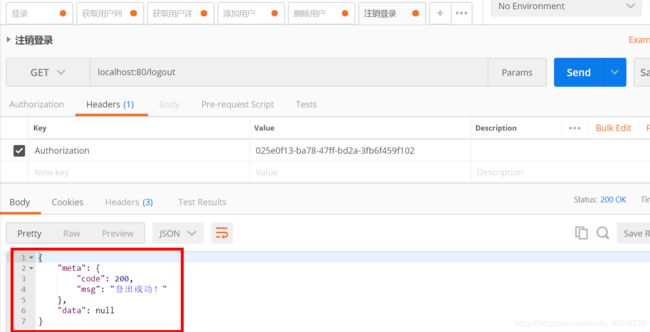


从redis中,再次查看,token消失了,简言之,用户登录信息,销毁了
注:不填写登录的token或者填写token不正确,会提示用户未登录

再次查询详情
gitlab项目链接:
https://gitlab.com/gb-heima/springoot-shiro-redis
git下载方式:
git clone [email protected]:gb-heima/springoot-shiro-redis.git
zip下载方式:
https://gitlab.com/gb-heima/springoot-shiro-redis/-/archive/master/springoot-shiro-redis-master.zip
